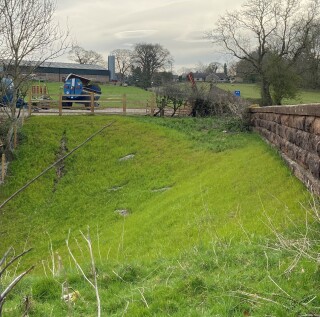A year after infilling Great Musgrave Bridge over the former Eden Valley Railway with 1,600 tonnes of structural fill and foamed concrete, National Highways has now applied for planning permission. It proceeded without permission or consultation last year on the assumption that it had permitted development rights and argued that the structure was at risk of collapse.
It has since emerged that the bridge was not at risk of collapse – it just needed some old-fashioned pointing work done – and National Highways did not have authority to override local democracy.
National Highways has responsibility for managing the Department for Transport’s Historical Railways Estate (HRE) – a collection of around 3,200 bridges, tunnels and viaducts, some of which carry or span routes earmarked for walking and cycling, or for reopened railways and extensions to heritage lines. Great Musgrave Bridge, which carried a minor road over a long-closed railway line, was one of more than 100 that National Highways designated for demolition or infilling to save maintenance costs.
An opposition campaign soon mobilised in the shape of the HRE Group – an alliance of engineers, cycling campaigners and greenway developers, coordinated by rail journalist Graeme Bickerdike. The Department of Transport then ordered National Highways to suspend the programme and have a re-think. Last week National Highways announced the formation of a ‘stakeholder advisory forum’ to give others a say but its demolition and infilling plans remain on the table.
The HRE Group is pressing Eden councillors to reject National Highways’ retrospective planning application – make it dig it out again and make good – to keep alive ambitions to use the old railway alignment to link up two heritage railway ventures.
![Great Musgrave Bridge before the infilling [©The HRE Group] Great Musgrave Bridge before the infilling [©The HRE Group]](https://www.theconstructionindex.co.uk/img-cache/08ea95111e374ec4eddeaa7e91dcd14b/320x213.33333333333_1651039756_greatmusgravebridgebefore©thehregroup.jpg)
The HRE Group has called on two civil engineers with experience of looking after Victorian structures to help support its case against infilling.
Tony Freschini was resident engineer on redevelopment of Euston Station in the 1960s and between 1990 and 1992 supervised the refurbishment of the Ribblehead Viaduct on the Settle & Carlisle Railway.
“I can’t imagine why anyone would infill Great Musgrave bridge,” he said. “The inspection reports make clear that there was really nothing wrong with it. Some of the minor defects may have occurred when the bridge was built in the 1860s. A few of the stone blocks had become loose over time, but repointing the open joints would have kept them in place. It just needed basic, day-to-day maintenance, costing a fraction of the price of infilling.

“All the efforts of the Victorians who expended capital and men’s lives on these valiant structures: we can’t just desert them by infilling bridges and forgetting about them. That’s not the right way - these are useful assets. We should look to preserve the best of the old infrastructure and give it a new life.”
Charles Blackett-Ord is engineering director of Blackett-Ord Conservation, responsible for extensive repairs to Lambley Viaduct on Northumberland’s former Alston branch.
“What happened with Great Musgrave bridge was a disgrace,” he said, “and brings shame on the engineering profession. There was absolutely nothing to justify it; quite clearly, there was no emergency here or any prospect of one. All the bridge needed was some pointing underneath the arch barrel which is a common, cheap and easy way of providing additional strength.
“Engineers have a duty not only to look at carbon footprints, but also the social, archaeological and historical aspects of what they do. Desecrating a structure like this is unacceptable and the planning application should certainly be refused.”

However, National Highways head of Historical Railways Estate programme Hélène Rossiter said: “We wrote to the heritage railway companies that comprise Eden Valley Railway Project to discuss the progress of their plans for the reopening of the line, including timescales and funding, so we could include their timescales in the planning submission and let the planning authority know when the infilling would likely be removed. Unfortunately the Eden Valley Railway Project’s plans were not sufficiently developed to provide the planning authority with that information.
“Our thorough internal review determined last year’s infilling was vital to public safety, and preserving the structure until a long-term purpose is found. We’ve committed to reversing it if a viable future use for the track bed beneath the bridge is found, that has all necessary approvals and is ready to be delivered.”
National Highways also supplied us with the image shown left of the bridge today, having been landscaped.
Comments on the planning application can be submitted online via Eden District Council’s website, searching for case reference 22/0254. The HRE Group understands that more than 300 objections were lodged in the first week after the plans’ publication. A decision on whether to grant permission for the infill’s retention is expected by 27th May 2022.
Got a story? Email news@theconstructionindex.co.uk


